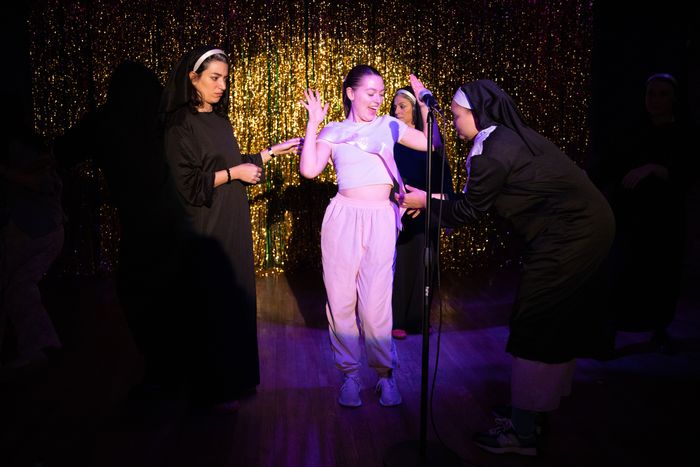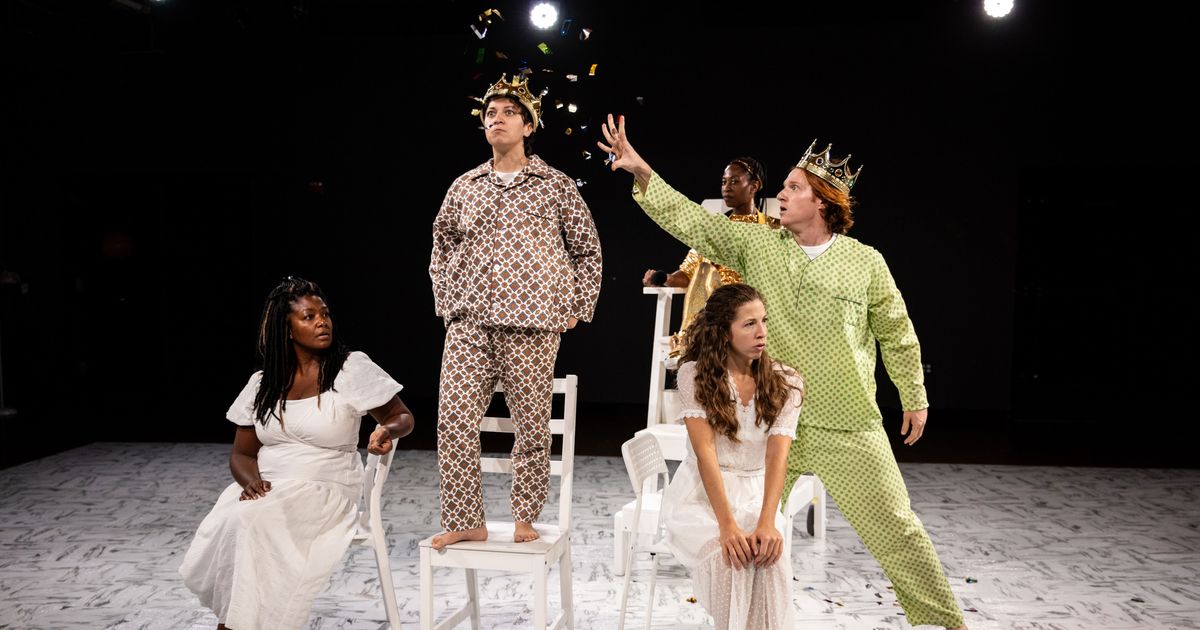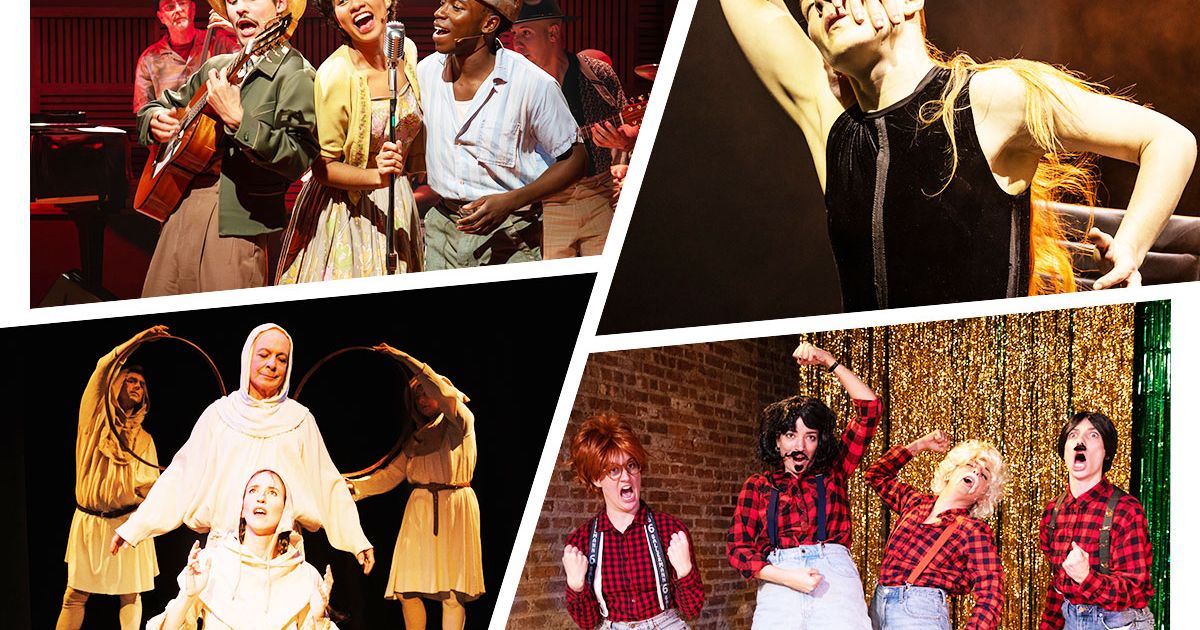Photo-Illustration: Vulture; Photos: Ahron R. Foster, Matthew Murphy, Walter Wlodarczyk, Leah Huete
A friend of mine once described herself as a playwright who doesn’t like plays. She can tell me after she reads this if I’m wrong, but I think what she meant is that, for her, a play is a text, a piece of writing with a particular, recognizable shape — plot, characters, stage directions, themes (especially themes) — that, in production, gives rise to a particular, recognizable kind of interaction with an audience. As objects, tangible scripts that you can see and reproduce and license, plays are easy to comprehend. Commissioning them, workshopping them, producing them, attending them — we know how to do it.
Theater, though, is something else. Theater can happen without plays. Plays can be its seeds, packed with potential wonders, but a whole medley of small miracles has to occur to produce the bloom — and the bloom is ephemeral, no matter how good the camerawork gets for National Theatre Live or BroadwayHD.
We know all this, but we’re also very good at forgetting it. The vast majority of our institutions are, still, designed for the cultivation and production of plays, rather than the creation of theater. We threw up our hands in dismay in 2022 when theaters reopened their physical doors and the crowds didn’t pour back in. But why was anyone surprised, when what was on offer was, overwhelmingly, exactly what always had been: not plays as blueprints for as-yet-unimagined, participatory marvels, but plays as expensive, walking-and-talking facsimiles of the infinite streaming content audiences can stay home and watch for nearly free while also snacking and scrolling and not wearing pants? Again and again, we return to the familiar, and what we are familiar with in America is not theater but plays (and, far more so, movies and TV), whether we’re galvanized by them or not.
There’s a book’s worth of history that’s gotten us here: Unlike Europe, Russia, and the U.K., we don’t have a robust theatrical commons — a bedrock of native texts old and sturdy enough to be open to constant, radical reworking. Shakespeare was premiering King Lear as the Virginia Company was sailing for what they would call Jamestown; four centuries later, though we produce his work all the time, we’re often still reverent and square about it. When we want real auteurship, we import it from abroad — from countries whose government support of the arts allows for long production processes, for the development of national theaters and repertory companies, for emergency support for artists and cultural passes for teenagers. American taste and capitalism drive us toward theater either as bankable spectacle or as statement of political values: Since we so often feel reduced to voting with our dollars, we put our season budgets and our ticket-buying funds toward plays that strive for immediate relevance rather than spiritual longevity. Do I simplify? Vastly. But the fact is that, by many twisting roads, we’ve reached a point where our theater consistently fails to make a case for itself as itself — as a visceral, temporal, communal happening that requires the vulnerable presence of your body and the full availability of your heart and mind.
There’s an emotional cost here, and all too often an exorbitant literal one — which is why shoddy theater feels not just disappointing but somehow distressing, even rude. (It violates Kurt Vonnegut’s No. 1 rule for writing: “Use the time of a total stranger in such a way that he or she will not feel the time was wasted.”) But when the thing that can happen really does happen, the cost is like the risk you take when you fall in love: wildly, stupidly, unforgettably worth it. Of course, there are a thousand ways something as complex and collaborative as a piece of live performance can stumble, but what interests me here is the question of text. When and how, in the crafting of an integrative event, does a play text become not a springboard but a trap? We privilege play-writing over play-wrighting — even, at times, unconsciously — yet often, the former ends up weakening the latter. What’s happening when it’s the words that are weighing down something that’s attempting to fly?
Buena Vista Social Club is unquestionably rich with moments of flight. The show — developed around the Grammy-winning album by a group of mid-century Cuban music legends who reassembled in 1996 and blew minds across the globe — is an exuberant burst of musicianship and choreography. There’s a real buzz in the audience before the lights dim, and as soon as Renesito Avich (a Cuban singer-songwriter and multi-instrumentalist who’s embodying Eliades Ochoa, Buena Vista’s incomparable tres player) steps forward to strum the first notes of “El Carretero,” people can no longer contain their cheers. The whoops resurface and are warranted throughout. With a cast of 17 plus nine more band members — all of whom are onstage together more often than not — the show generates an energy that rolls out into the house in great, bracing waves. At its best, it’s a truly loving celebration of its source material, a tribute concert by a group of artists who are virtuosos in their own right.
Where it’s not at its best is in its script. Perhaps inevitably, Buena Vista the musical is more overtly heartstring-tugging than the wonderful documentary Wim Wenders made in 1999. It wants to tell a juicy story, and so the book writer, Marco Ramirez (known for The Royale), and the director, Saheem Ali (who’s also credited with developing the show, with the creative consultancy of The Band’s Visit’s David Yazbek), craft a fictional narrative around the real people of Buena Vista — most centrally, the singers Omara Portuondo (played as a young woman by the glowing Kenya Browne and, 40 years on, by the queenly Natalie Venetia Belcon) and Ibrahim Ferrer (Olly Sholotan and, as an older man, Mel Semé). “Some of what follows is true,” we’re told at the start by Juan de Marcos (Luis Vega, playing the musician-producer largely responsible for getting the real band back together). “Some of it only feels true.” Whether it’s truth or fiction, what it predominantly feels is polished: neat and expected.
Not far away, Alicia Keys’s Hell’s Kitchen — which took approximately five minutes after opening to announce its transfer to Broadway — has a similar by-the-numbers quality. There’s no way Buena Vista isn’t also gunning for a move uptown, and the depressing thing is, Ramirez’s script (like Kristoffer Diaz’s) is clearly a calculated part of that gambit. While the musicians and singers are sending their souls up to the rafters, and the dancers are dancing their butts off, the play side of Buena Vista feels like it’s been carefully assembled by committee. There’s a kit for this kind of writing: Say something profound at the show’s beginning, and then repeat it again verbatim — now for added profundity — at the end. Have a character deliver a passionate speech to a skeptical listener, then have that listener say, “Did you rehearse that?” to communicate your awareness that the speech is part of the formula. Make a sentimental case for the importance of art (“What if the world is on fire and we’re singing pretty songs?” / “The world needs pretty songs”). Introduce a character who used to be “Picasso on the keys,” “the reason God invented piano,” and is now a hunched, abstracted old man who “doesn’t play anymore” — but then have him return to the instrument and pick out a few perfect notes at just the right moment.
These tidy and overfamiliar turns let us — whether audience members or theater-makers — sit back, secure in our knowledge of how stories like this work. And they give rise to dialogue that can’t help but thud in many actors’ mouths. (In Buena Vista, the cast members most nimbly sidestepping the potholes of cliché are the wonderfully at-ease Julio Monge as Compay Segundo, guitar virtuoso and incorrigible 90-year-old lover of cigars and women, and Browne, whose young Omara is so light and artless that she seems to float.) The ultimate effect — that is, between the sparkling musical numbers — is one of hindered transcendence, and on this island of countless amazing singers and amazing dancers and amazing musicians and amazing designers who regularly find themselves working on deeply conventional plays, it’s a painfully common one. In Buena Vista, the band is a joy, the voices fantastic; Dede Ayite’s lush costumes live beautifully against the richly aging Old Havana architecture of Arnulfo Maldonado’s set; and the married choreographer pair, Patricia Delgado and Justin Peck (who’s been flying high ever since winning the Tony for Carousel), make marvelous use of the relatively small stage. At the Atlantic’s Linda Gross Theater, the space is wide but fairly shallow and often occupied by the full band, but the show’s dancers twist and thread and leap their way through every spare inch of it, blending samba and salsa with acrobatic ballet and expressive modernism. That the play text of Buena Vista Social Club doesn’t rise to the show’s theatrical heart — which is its gorgeous, defiant music and its precise and vivacious dance — is less an individual failing than it is part of a widespread cultural phenomenon. By starting with the known and highly salable, it’s possible to build something that contains beauty; it’s much harder to make something that sparks revelation.
Buena Vista Social Club is intended to be a commercial show, and some of this straightforwardness is part of its business, wherever it might leave the art. What’s trickier is when theater with entirely different means and ends — the devised, the scrappy, the experimental, the “downtown” — somehow winds up similarly hampered by language, by the part that can be written down. Richard Foreman talked about attempting to frustrate “the inevitable drift into normal, narrative form” — the part of our art-making (and art-experiencing) brains that can’t help but hear the siren song of structure and story, no matter how much radical, postmodern wool we stuff in our ears.
To be clear: I love stories. I will happily watch Characters engage in a Plot, just as happily as I’ll engage in a Foreman-esque “series of multidirectional impulses and collisions,” as long as Dionysus is in the room. But it’s not the narrative part that’s worrisome — it’s that “inevitable drift.” We live in a playwriting culture, not a theater-making culture, and even in the pursuit of the unconventional, the tractor beam of words and meaning can get switched on automatically, at times pulling us away from potentially more resonant forms of expression.
Happenstance Theater’s ADRIFT: A Medieval Wayward Folly (currently visiting 59E59), Leonie Bell’s SchmidtSmithSchmidt (at the Brick in Williamsburg), and Jenn Freeman and Sonya Tayeh’s Is It Thursday Yet? (a dance-theater piece, now at the Perelman Performing Arts Center) might seem like pretty widespread dots on the live-performance map. Happenstance, a physical theater troupe with an affection for puppetry and fanciful aesthetics, has built a droll postapocalyptic pageant around the paintings of Hieronymus Bosch. Bell, who makes work with her irresistibly named theater company Local Grandma, is telling a set of whimsically intertwined stories about several generations of women in the German suburbs, where the local government has shoved most of the population into a dismal “prefab monstrum” apartment block, and there used to be witches in the woods, but now the sacred groves are dying and the forest is off-limits unless you’re a man. And Jenn Freeman — dancing solo while accompanied by a percussionist and the show’s composer, the vocalist and soundscape artist Holland Andrews — is exploring the personal effects of receiving an autism spectrum disorder diagnosis in 2021, when they were 33 years old. In plenty of respects, the three shows are apples and mangosteens — but each one has a script that, at least at this stage in its development, feels like it’s holding back what could otherwise be a fuller, freer flow of truly exciting, distinctive theatricality.
Devised and designed by its five-person ensemble (who also built the puppets, props, sets, and costumes themselves), ADRIFT is great fun to look at — a playful, meticulously crafted living diorama of strangely familiar, and familiarly strange, allegorical imagery. It begins with a particularly lovely sequence in which the performers Sarah Olmsted Thomas and Alex Vernon (they’re a married double act who also perform their own puppetry creations as Alex & Olmsted) hold up a hoop with the painted image of a landscape inside — but then, Vernon blows gently on the painted trees, and they bend and sway with the wind of his breath.
It’s the kind of sweet, specific trick that makes you feel like a kid at a magic-lantern show, and if ADRIFT were made up entirely of this kind of delicate nonverbal storytelling, it might be a real jewel. Drawing its central conceit from Bosch’s Ship of Fools, the ensemble has created a series of variety-show-style vignettes, loosely connected by a central group of hapless clowns who, having weathered the end of the world, find themselves packed together in a tiny boat wondering, “What do we do now?” There are appearances by an overenthusiastic medieval dentist (Gwen Grastorf); a serenely wide-eyed fool (Mark Jaster, one of Happenstance’s artistic directors, whose mime training and study of Buster Keaton and Harpo Marx are evident); a pair of misty-eyed oracles with intertwined hats (Vernon and Sabrina Mandell, Jaster’s co–artistic director); and a furry, flatulent, horned-and-horny demon (Thomas). Every so often, a flat-painted bum and legs emerge from the wings — cheekily? — allowing a scroll with some important message on it to unfurl from guess-where. If they’d thought of it, the creators of Spamalot might have gone there.
Since the players of Happenstance have given such loving, minute attention to the visual craft of their world — and often to the music, which the troupe plays and sings live, pulling from Hildegard Von Bingen and a range of medieval traditionals — it’s discouraging that the script of ADRIFT has a baggy, generalized quality to it. Worse, at times it turns cloying and cutesy. (Grastorf’s scary-dentistry sketch is an especially worn-out piece of shtick.) The show suffers from a common problem inherent to clowning, which is that bits go stale before they’re over. We’re ready to move on, but the performers are still giving us jazz hands. The variety-show format can be a pleasure, but it’s got to be tight: Asking for applause for the same trick on the third or fourth go-around is bound to yield tepid results.
It’s this textual looseness — a good-natured but not quite rigorous tone — that ADRIFT shares with SchmidtSmithSchmidt. But while it’s easy, and even exciting, to imagine the former as a wordless piece, one that’s even more committed to its rich visual and physical vocabulary, Bell’s play needs its language. Its characters are navigating border spaces: between German and English, between city and forest, between the seductions of modernity and the aching tug of ancestry, and eventually, perhaps inevitably, between life and death. In this liminal spirit, the show is wrapped in a light layer of metatheatricality: Before it starts, Bell welcomes us and, before disappearing backstage (she’s a performer, too), enthusiastically thanks “the local convent St. Mary’s Nunnery for offering their sisters as crew and stagehands.” Thereafter, between scenes, SchmidtSmithSchmidt’s seven actors shuffle back and forth across the stage wearing comically cheap polyester habits, munching on potato chips and making small talk. When they’re not their principal characters, they’re the sisters, grousing genially as they go about their show-running tasks and shouting profanities at each other from backstage.
Whether as nun-characters or character-characters, the folks who inhabit this stage world seem to know they’re in a play. Lottie the Librarian (Marcella Murray) introduces herself to us by holding a flashlight under her face and whispering her own stage directions into a mic. She’s an American expat, a kindhearted lost soul who moved to Germany one day and ended up living with a gutsy old granny named Eunice Geld (Rawya El Chab). Lottie’s story — she’s worried that “the municipals” will find out that she and Eunice are in fact squatting in their garden allotment, and she’s fascinated by the rumors of witches in the woods — weaves together with that of Susi (Hanna Westi), a teenager with plans to run off to America to reunite with her dad (she longs to be “Brandy Smith,” not Susi Schmidt) and with the shenanigans of Eunice’s crew of local grandmas, the glamorous, martini-slinging Erna (Lianne Elsouki) and the deadpan, fanny-pack-rocking Ida (Caroline Burkhart).
SchmidtSmithSchmidt isn’t overlong on plot — eventually, as in all green-world plays, everyone ends up in the mystical, matriarchal woods together as the generations try to sort things out. What it does possess is abundant warmth and an appealingly mischievous energy. The ensemble is credited with helping Bell complete the play text, and you can tell how much they genuinely enjoy each other’s company. That’s the upside of a joyful devising process. The downside of that same process can be that a show retains a semi-improvised sagginess that comes across less as intentional texture and more as a dribbling-away of dramatic energy. In SchmidtSmithSchmidt, many scenes still feel a bit like drafts: exercises that the company did together to generate ideas, and that were probably a hoot, but that have been brought to the stage in pretty raw form — their repetitions a few too many, their through-lines a little underhoned, and their humor at times more rewarding to the performers than to the audience.
It’s a delicate maneuver to pull off: maintaining a cheerfully eccentric, liberated energy while also keeping hold of the reins. The uneven stand-up nature of SchmidtSmithSchmidt’s script sticks out in part because it’s sitting on top of a box of enchanting theatrical vocabulary that the show could stand to pull from even more freely. Bell’s forest is a series of glitter curtains, and her potty-mouthed nuns introduce us to the play’s setting by illuminating cutout figures of mountains, forest, apartment block, and moon inside a rough-hewn little light box. Now and then, moments of choral singing and unison movement evoke the choreographer Yvonne Rainer’s blending of the dancerly and the mundane. I longed for the show to venture further down these forest paths of movement, music, and scrappy-beautiful spectacle. In them, Bell has such highly charged engines: They could power her play more fully if she asked them to.


From left: SchmidtSmithSchmidt. Photo: Walter WlodarczykBuena Vista Social Club. Photo: Ahron R. Foster
From top: SchmidtSmithSchmidt. Photo: Walter WlodarczykBuena Vista Social Club. Photo: Ahron R. Foster
Given that Is It Thursday Yet? is explicitly a dance piece — and Jenn Freeman themself doesn’t speak until the show’s very end — it’s surprising to find Freeman and Tayeh leaning even more heavily, and heavy-handedly, than the makers of Schmidt and ADRIFT on an edifice of words. Freeman’s dance unfolds mainly in an open space in front of a projection screen, surrounded by the artful detritus of Rachel Hauck’s set. This bric-a-brac is part theatrical and part nostalgic — a combination of lighting instruments, ladders, and fly ropes with a jumble of objects from Freeman’s childhood, plus 12 old TV sets scattered here and there. All the screens, big and small, keep flickering with imagery, from live-feed video of Freeman and home movies from their childhood to up-close renderings of their ASD diagnosis, as delivered by their doctor, the psychologist Dr. Kimberly Gilbert, Ph.D.
It’s the real Gilbert, in recorded voice-over, who provides almost all of the text for Is It Thursday Yet? The doctor speaks — delving into the varied aspects and implications of the diagnosis and analyzing her patient’s behaviors, emotions, and experiences of the world — and Freeman dances. Bolstered by the pulsing, ethereal singing and live mixing of Holland Andrews, who often incorporates phrases from the voice-over into their soundscape, Gilbert’s flow of language is the play’s score. Though Andrews and the percussionist Price McGuffey are generating music almost constantly, the overwhelming impression of Is It Thursday Yet? is of watching a dancer illustrate a spoken soliloquy.
And there’s the rub: illustrate. Though Freeman is a muscular and graceful dancer — with a pale-fiery severity that kept reminding me of the pre-Raphaelite model and artist in her own right, Elizabeth Siddal — the motions they’re going through are often stultifyingly literal. When Gilbert describes how social situations can be overwhelming for people with ASD (“They’re having to process each and every person … Are they receiving me well? I’ve got to read their face. What are their eyes doing? What should my tone be? How close do I stand? How far away do I stand? It’s exhausting”), Freeman stands stiff, eyes darting and muscles twitching as Andrews throws various well-meaning social niceties at them: “Hey, you actually made it!”; “Did you get my text?”; “Jenn, over here! Do you remember me?” When Gilbert reminds Freeman that, as a child, they used to organize the books at their school library — which fits with the common desire of folks with ASD to “try to order things to … make their anxiety less” — Freeman reveals an oversize bookshelf at the back of the set, climbs up it, and cheerfully arranges books by color as Andrews sings, “Order is the way / I can feel okay … Green, red, blue / Gray and yellow too.” Gilbert talks about hyperreactivity to sensory input, and Freeman puts on gloves and noise-canceling headphones while dancing to a cacophonous crescendo of sound and light. Gilbert describes burnout — “the tendency to do the extreme” or lacking a “good pain sensor,” to “push yourself to the point where you’re falling onto the floor” — and Freeman walks over to Andrews, who climbs onto their back. While Andrews intones, “This isn’t enough, I’ll do more, I’ll do more” into a handheld mic, Freeman drags their dead weight around the room.
Perhaps Freeman and Tayeh intend for the relationship between text and movement in their piece to be a point of accessibility: Say the thing and do the thing — make it explicit, don’t leave anyone behind. While that’s a worthy goal, I question the assumption that the abstract is necessarily the unavailable. Onstage, if the body is telling us something, the text need not always hammer it home. If the text is telling us something, shouldn’t the body — and the entirety of the mise en scène — add depth, dimension, even contradiction to it? Isn’t one of theater’s great opportunities the dynamic manifestation of metaphor? Watching Freeman struggle to carry Andrews across the stage is, in and of itself, a compelling image, but Gilbert’s running commentary has stripped us of our own ability to make complex meaning out of it. Similarly, when the stage’s multiple screens fill up with sad, rainlike columns of words — Lonely, Isolation, Imposter Syndrome, Taxing, Draining — Freeman’s accompanying movements are, paradoxically, sapped of emotional heft. We may be learning, accurately and explicitly, what Freeman has felt, but our own experience has been flattened in the process.
Not talking is frightening. The rich ambiguity of silence can, especially in our ultra-anxious cultural moment, feel like a risk: If I don’t explain myself, I may be misinterpreted. But fear is ever the art-killer. Writing that pushes a play toward the ecstatic leap into theater isn’t easy or ordinary or formulaic. It has to be a commitment to both interrogation and trust — sometimes, a trust that theater has tools beyond the word, and that expressing more might mean saying less. It’s a struggle against the undertow: If we don’t row hard for unknown waters, our boats drift toward the familiar shore.
Buena Vista Social Club is at Atlantic Theater Company through January 21.
ADRIFT: A Medieval Wayward Folly is at 59E59 through December 24.
SchmidtSmithSchmidt is at the Brick through December 17.
Is It Thursday Yet? is at PAC through December 23.











